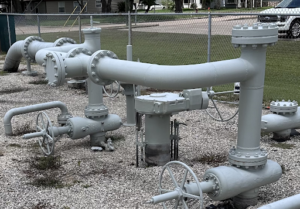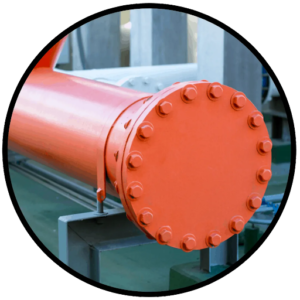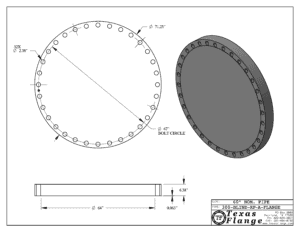Blind flanges are important elements in the world of piping systems and pressure vessels. They serve an essential role by sealing off the ends of pipelines securely. Typically made from steel, these flanges create a strong and airtight seal, ensuring the integrity of pipelines. They come in various sizes, materials, and shapes to meet diverse pipeline requirements. Choosing the appropriate blind flange is vital for reliable performance, preventing leaks, and ensuring safety. In this article, we delve into the key factors to consider when selecting blind flanges, which are essential for smooth pipeline system operation.
Image source: Texasflange.com
Key Considerations When Choosing Blind Flanges
Image source: Texasflange.com
Selecting the right components for a pipeline system requires careful consideration of several key factors to ensure optimal performance and safety. These factors include:
1. Pipeline Size and Type:
- Matching the size of the flange to the pipeline size is essential to achieve a secure and leak-free seal. Mismatched sizes can lead to leaks, requiring costly repairs and causing downtime.
- The type of pipeline also influences the selection of the flange material. For pipelines carrying hazardous substances, specific materials are necessary to withstand challenging conditions. The pipeline type can also affect the design and shape of the blind flange. High-pressure pipelines require thicker flanges, while those operating under a vacuum need special raised-face attachments for tight seals.
2. Flange Material:
- The material used to make a flange determines its strength, durability, resistance to corrosion, and ability to handle temperature variations. Flanges can be constructed from a range of materials, including steel, stainless steel, and cast iron.
- Steel flanges offer robustness and durability, making them ideal for various industrial applications. Stainless steel flanges are chosen for their corrosion resistance, making them suitable for pipelines carrying corrosive fluids. In contrast, cast iron flanges are more budget-friendly and find use in pipelines carrying non-corrosive fluids.
3. Flange Dimensions:
- Flange dimensions encompass aspects such as diameter, bolt circle diameter, the number of bolt holes, bolt size, and thickness. The flange diameter must align with the pipe’s diameter, while the bolt circle diameter should match that of the pipeline.
- The pressure rating of the pipe determines the number of bolt holes, bolt size, and flange thickness. It is crucial to note that flange dimensions may vary depending on the flange type and standards, such as ANSI, API, and ASME. Consulting industry standards is imperative to ensure the correct dimensions for a specific system.
4. Pressure Rating:
- The pressure rating of a flange indicates its capacity to withstand pressure without leaking or failing. This rating is closely linked to the maximum allowable working pressure (MAWP) and temperature rating, both of which differ based on the flange rating.
- Opting for a flange with a higher pressure rating than the pipeline’s operating pressure is essential for efficient operation.
5. Compatibility with Gaskets:
- Gaskets play a critical role in creating tight, leak-proof seals between flange faces. However, the choice of gasket material and design depends on the flange type and material.
- Soft gaskets made from materials like rubber or PTFE are suitable for low-pressure applications, whereas metal gaskets are better suited for high-pressure situations.
Image source: Texasflange.com
FAQs (Frequently Asked Questions)
What is a Blind Flange?
A Blind Flange is a solid disk-like component used in piping systems to seal off the end of a pipeline. It has no opening for fluid flow.
Where are Blind Flanges commonly used?
Blind flanges are frequently used in industries such as petrochemical, water works, and public services for pipeline isolation, maintenance, and flow testing.
What is the purpose of a Blind Flange?
The primary purpose of a Blind Flange is to block off a pipe or vessel nozzle that is not in use, creating a secure seal.
What materials are Blind Flanges typically made from?
Blind flanges can be made from various materials, including carbon steel, stainless steel, alloy steel, and even cast iron, depending on the application.
How does a Blind Flange prevent leaks?
Blind flanges create a tight seal by pressing against a gasket located between the flange faces, preventing fluid or gas from escaping.
What factors should be considered when selecting a Blind Flange?
Important factors include pipeline size, type, material, dimensions, pressure rating, and compatibility with gaskets.
What are the different types of Blind Flange faces?
Blind flanges can have raised face, flat face, or ring joint (RTJ) faces. RTJ is often preferred for higher pressure applications.
Can Blind Flanges be customized for specific requirements?
Yes, Blind Flanges can be customized in terms of size, material, and other specifications to meet the needs of a particular application.
What is the pressure rating of a Blind Flange, and why is it important?
The pressure rating of a Blind Flange indicates its ability to withstand pressure without leaking. It must be higher than the pipeline’s operating pressure to ensure safety.
Are there specific gasket materials used with Blind Flanges?
Gasket materials vary based on the application. Soft gaskets like rubber or PTFE are suitable for low-pressure scenarios, while metal gaskets are used in high-pressure applications.
How do Blind Flanges differ from other types of flanges?
Blind Flanges have no openings or bore, making them suitable for blocking off pipelines entirely. In contrast, other flanges have openings for fluid flow.
What is the purpose of vents in Blind Flanges?
Vents are sometimes added to Blind Flanges to release trapped pressure or gases, improving safety during maintenance or repairs.
Can Blind Flanges be used in both high-pressure and low-pressure systems?
Yes, Blind Flanges can be used in a wide range of pressure systems, but the selection must consider factors like material and dimensions.
Are there any safety considerations when using Blind Flanges?
Yes, safety is crucial, especially when dealing with high-pressure systems. Proper material selection, pressure rating, and gasket compatibility are essential for safety.
Can Blind Flanges be reused, or are they typically replaced after use?
Blind Flanges can often be reused, but it depends on the specific application and condition of the flange. Inspection and maintenance are important to ensure their continued effectiveness.
Conclusion
In summary, blind flanges are indispensable components in piping systems, ensuring the secure sealing of pipelines. The process of selecting the right blind flange involves considering pipeline size, type, material, dimensions, pressure rating, and gasket compatibility. These considerations are vital for achieving optimal pipeline system performance, preventing leaks, and enhancing safety, making blind flanges integral to the functionality of pipelines in various industries.
For more in-depth information on Blind flanges and their applications, visit: https://www.texasflange.com/blind-flanges/


